Login form
Tet-The Lunar New Year
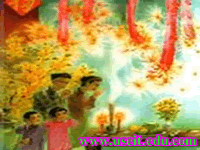 In Vietnam, the first day of the Lunar New Year is called Tet. On the days before Tet, people plant an extremely tall bamboo tree in front of their homes.
In Vietnam, the first day of the Lunar New Year is called Tet. On the days before Tet, people plant an extremely tall bamboo tree in front of their homes.
Bows, arrows, bells and gongs are hung on the treetop with the hope that all the bad luck of the past year will be chased away and everyone will have a happy New Year. The tree is called neu and the story is legend.
Once upon a time, the devil ruled the earth. Everybody worked for him from early morning until midnight. A very greedy creature, the devil seized everything made by men for himself. People worked hard all year round but had almost nothing to eat. All the fruits of their labor went into the devil's warehouses.
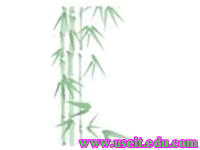 One year, there was a very big crop. Rice fields stretched out like golden carpets and the devil was so dazzled, he aimed to take everything and imposed a new rule "the root of the rice plant belongs to the farmers, the rest belongs to the devil." At the end of the harvest, the rice went to the devil. The people had nothing left except clusters of roots.
One year, there was a very big crop. Rice fields stretched out like golden carpets and the devil was so dazzled, he aimed to take everything and imposed a new rule "the root of the rice plant belongs to the farmers, the rest belongs to the devil." At the end of the harvest, the rice went to the devil. The people had nothing left except clusters of roots.
The suffering of the people came to Buddha's notice. He descended to earth and told them to grow sweet potatoes for the next crop. Following Buddha's advice, the farmers grew sweet potatoes with full hopes of an abundant crop. When harvest came, following the rule, the peasants took the potato root and left the rest for the devil.
Knowing that he had been fooled, the devil gave a new order: " From the next crop onward, both roots and grown plants will belong to the devil, and the rest to the farmers." This time, the devil believed he would get the upper hand. In the next crop cycle, the people grew corn instead where maize cobs grow in the center of the plant. Once again when harvest came, the farmers took all the cobs and left the rest behind for the devil. Again the devil was outsmarted. This time, he made up his mind to take all of the land and the farmers had no more land to farm.
Because of the people's misfortune, Buddha appeared again and they began to complain: "How can we live like this?" "Don't worry" answered Buddha. "Go tell the devil that you want to rent his land for gold. Just rent a small plot of land enough for a single bamboo tree. Make sure that the devil will vow that all land under the bamboo's shadow will belong to you." The people then collected all the gold they had and went to negotiate with the devil. Stunned with the gold and believing that they would certainly be defeated, the devil agreed with the plan at once.
Bamboo trees were planted and they grew straight and luxuriant. Their shadow spread far and wide with every passing year. The longer they lived, the more immense their shadow became. Finally, one day there was no more land for the devil who was driven out to sea. Since then the people have been free to plant any kind of crop they want without giving a portion to the devil.
Being deprived of his land, the devil wanted vengeance at any cost and swore to retrieve his former land. With the support of wild and ferocious beasts, he let his subjects go to the village to plunder and loot the crops. Armed with spears and sticks, the people fought against the hostile forces to guard the rice fields they had gained at the expense of their own lives. At the same time, Buddha appeared and advised them to "Go to the forest and make bows and arrows to kill them and make use of water mingled with garlic and lime to splash on their faces." Following Buddha's advice, they made the weapons and waited for the enemy. When the devil came with his gang, they met tough resistance from the farmers. Leaving their enemies behind, the living survivors ran in every direction.
After that enormous defeat, the devil was put back out to sea and gave up his ambitions to regain the land. His only wish was that every year he be allowed to return to his former native village for a visit to his ancestors' graves.
This is the reason why every year when Tet comes, farmers plant a neu tree in front of their house. The shadow of neu symbolizes the land acquired by the men in the legend. The sounds of small bells and gongs on neu remind us of man's right to own the land and the bows and arrows tell us that they were once the weapons used to fight off the devil.
TET NGUYEN DAN -The Lunar New Year
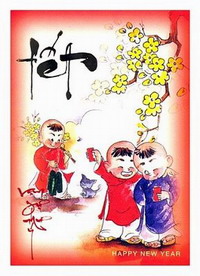 Tet starts on the first day of the first lunar month and is the first season of the new year (according to the lunar calendar), and therefore it is also known as the Tet Nguyen Dan, literally meaning Fete of the First Day, or the Tet Tam Nguyen, literally meaning Fete of the Three Firsts.
Tet starts on the first day of the first lunar month and is the first season of the new year (according to the lunar calendar), and therefore it is also known as the Tet Nguyen Dan, literally meaning Fete of the First Day, or the Tet Tam Nguyen, literally meaning Fete of the Three Firsts.
The Vietnamese, wherever they may be, are all thrilled and excited with the advent of Tet, and they feel an immense nostalgia, wishing to come back to their homeland for a family reunion and a taste of the particular flavours of the Vietnamese festivities. Those who have settled down abroad all turn their thoughts to their home country and try to celebrate the festivities in the same traditional way as their family members and relatives to relieve their nostalgia, never forgetting the fine custom handed down from generation to generation.
The Tet of the New Year is, above all, a fete of the family. This is an opportunity for the household genies to meet, those who have helped during the year, namely the Craft Creator, the Land Genie and the Kitchen God. As the legend goes, each year on December 23 of the lunar calendar, the Kitchen God takes a ride on a carp to the Heavenly Palace to make a report on the affairs of the household on earth and then returns on December 30 to welcome the New Spring.
Tet is also an opportunity to welcome deceased ancestors back for a family reunion with their descendants. Finally, Tet is a good opportunity for family members to meet. This custom has become sacred and secular and, therefore, no matter where they are or whatever the circumstances, family members find ways to come back to meet their loved ones
Vietnamese Tet has quite a few original practices with customs and entertainment that have distinct Vietnamese cultural characteristics. In the framework of this article, a few customs and practices are presented so that readers can better understand the traditional Tet of Vietnam.
Some days before Tet Ong Tao (on the 23rd of the twelfth moon), people start their preparations for the Kitchen God's journey to the Heaven to make his report to the Jade Emperor. This report includes the year's activities of the household in which he has lived. A farewell and thank-you dinner is given to the Kitchen God at Tet Ong Tao. The Kitchen God will need a week for his mission to Heaven.
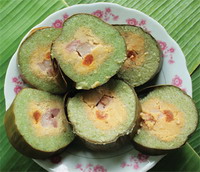 After the Kitchen God has gone to the Heaven, preparations for the New Year festivities begin in enthusiasm. The week before New Year's Eve is called a period of "Tat Nien". Tat Nien (literally meaning the end or "to extinguish the year") is the celebration of the last session of a period, such as the last class of school, the last day in the office, even the last bath, all with parties and great ceremonies.
After the Kitchen God has gone to the Heaven, preparations for the New Year festivities begin in enthusiasm. The week before New Year's Eve is called a period of "Tat Nien". Tat Nien (literally meaning the end or "to extinguish the year") is the celebration of the last session of a period, such as the last class of school, the last day in the office, even the last bath, all with parties and great ceremonies.
Some families set up a Tet tree outside the house in the week before New Year's Eve. The Tet tree, called cay neu, is a bamboo pole stripped of its leaves except for a tuft on top. It is supposed to ward off the evil spirits during absence of the Spirit of the Kitchen God.
Sweeping and scrubbing must be done during this time as tradition discourages it during the Tet holiday. Two items required for the proper enjoyment of Tet are peach flower branches and kumquat trees. Throughout the country, on bicycles of roving vendors, flowers create great splashes of color. In the north, the soft rose-colored dao peach flowers decorate homes and offices while the bright golden yellow branches of the hoa mai are preferred in the south.
Kumquat trees, about two or three feet tall, are carefully selected and prominently displayed. To carefully choose a kumquat tree, the buyer must pay attention to the symmetrical shape, to the leaves and to the color and shape of the fruit. The bushes have been precisely pruned to display ripe deep orange fruits with smooth clear thin skin shining like little suns or gold coins on the first day. Other fruits must still be green to ripen later. This represents the wish that wealth will come to you now and in the future.
When Tet is approaching, crowds of shoppers at the markets become thicker and more frantic each night, holding up traffic as they jostle each other to reach the counters with the best buys. Prices are a bit higher, but thriftiness is not considered a virtue at Tet.
While shoppers roam the streets, banh chung patties wrapped in leaves are steaming in giant vats. After being boiled until the outside of banh chung has taken on a lovely light green tinge, it is taken out of the vats and cooled. Banh chung will be eaten and used as offerings to worship ancestors during Tet.
Before the New Year's Eve, shops, stalls and restaurants are locked, leaving a notice hung on the door announcing the date of reopening. Special dishes must be completed to serve the family and its guests for the first three days of the new year.
midnight approaches, all eyes maintain a close look on clocks and watches. The Giao Thua ritual occurs at that most sacred moment in time. At midnight on the last day of the year, every Vietnamese family whispers similar fervent prayers. Bells ring and drums beat in temples. The old year gives over its mandate to the New Year. The word Giao means to give and Thua means to receive, so Giao Thua marks the magical transition time from one year to another. Those who practice Buddhism will pray in the pagodas.
In the Gia Tien (family ancestor) ritual or calling of the ancestors, invitations are extended to the deceased relatives to visit for a few days in the world of the living family. They are invited to return home and kept happy until they leave. During this sacred ritual the head of the household lights incense and folds hands at heart level in the position of prayer. The prayer may proceed as follows: "It is the year of ... and the date of ..., we would like to make these offerings and invite all of our ancestors to join in eating Tet with us."
The past generations are invited to share the family's joys and enjoy meals with the living during Tet, to catch up on the family news and to lavish riches and honors on their descendants.
Bowing motions, called Le, are performed at least three times and the ceremony ends when all have prostrated themselves (or in more modern families, folded hands and prayed) before the altar. After the "money for the dead" and other paper gifts are burnt in the courtyard, the family watches the ashes dance away on warm currents of air, a sign that the dead have received their gifts. The spiritual presence of the ancestors will be palpable during the days of Tet.
There is a Vietnamese saying related to ancestor worship: "Trees have roots; water has a source; when drinking water from the spring, one must remember the source." Thanks are offered to those ancestors who labored long ago to dig irrigation channels and remove mountains for this generation to have an easier life. The present is only one link in the cycle of coming back to the past as one looks to the future.
In recent times, a new tradition has evolved to celebrate the important evening of the new year. Those who are not at home praying at this momentous time may be socializing with friends. In the cities, there will be community fireworks displays that will draw the young from their homes into city centres. Although firecrackers are now illegal in Vietnam, some kind of loud noises will be made. It can be the banging of cans, the use of electronic popping firecrackers or human voices whooping it up.
People will break off small branches and twigs that contain newly sprouted leaves to bring a sense of freshness and vitality into their home. This follows a Buddhist tradition of bringing fresh new leaves and "fortune bearing buds" into the home from the pagoda.
Ancestor Worship
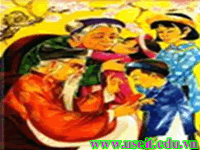 Ancestor worship has deep roots in the Vietnamese psyche. It has been playing an important role in the Vietnam's society throughout the history: in feudal times when Vietnam was influenced by Confucianism, in French time and in the present time. Ancestor worship is to express respect to the deceased ancestor. Several well-known sayings illustrate this: "Birds have nests, humans have ancestors" and "A single drop of blood is worth more than all the water in the pond".
Ancestor worship has deep roots in the Vietnamese psyche. It has been playing an important role in the Vietnam's society throughout the history: in feudal times when Vietnam was influenced by Confucianism, in French time and in the present time. Ancestor worship is to express respect to the deceased ancestor. Several well-known sayings illustrate this: "Birds have nests, humans have ancestors" and "A single drop of blood is worth more than all the water in the pond".
The Vietnamese people worship their ancestors by lighting incense and praying for them, and by offering them nourishment, paper money and effigies. A folk song illustrates this:
"The year was at its end; it was the last day of the Twelfth Month, The widow of a spirit was offering him money and paper effigies. She called out: spirit of my dear husband, these are for you She held up in one hand a string of coins And in the other an effigy of the deceased, and threw them into the water. The string of coins sank to the bottom because it was heavy; While the effigy floated on and on, being light. Listen now, good people! Isn't it a rule the world over that money carries more weight than any man?"
The Vietnamese people do the worship for their ancestors in special ceremonies, especially at Tet. There is also a time of the year called "Pure Brightness" which may last three months beyond Tet. This is a time for tidying up the graves, burning gold paper and coins, and the offering to the dead fresh flowers, water and steamed glutinous rice and boiled chicken.
Not every deceased person has his or her descendants to worship them. There are miserable wandering souls who have no one to pray for them. So they are called "hungry souls." In seeking nourishment and relief, these spirits may cause problems for the living. Ceremonies are, therefore, held on the 15th day of the seventh moon to give offerings to these souls. They are presented with paper money and gold, paper models of clothing, and paper houses, servants, motorbikes or cars. These paper models are burnt at the end of the ceremonies as they are believed to serve the souls in their world.
In the home of every Vietnamese family there is an altar for ancestor worship. This altar is afforded the highest and most important place in the largest room of the house. Some altars can be very elaborately-made ones and take up an entire small room or an entire small house of the family. Above the altar is placed a photograph of the most recently deceased and surrounded by a lacquer board inscribed with the names of earlier ancestors. There are incense burners, candle sticks, and small trays for offerings. There may be a small drum and tiny bell to call back the dead during Tet and death anniversaries.
The lighting of incense (as is the burning of paper gifts of clothes and money) is a form of communication between the real world and the world of the dead, between Heaven and Earth, between Man and the Gods. When incense is burnt into smoke, this transformed substance can be "received" by the spirits and can also be breathed by man, thus it helps them communicate.
Incense comes from a fragrant paste extracted from the sap or bark or sawdust of trees and shrubs. It provides a fragrant smoke when burned to provide a pleasant ambiance and inspire the gods and to put them in a favorable mood to receive the prayers of devout. Incense aids meditation and concentration. According to each particular occasion, one may light one, three, five or seven sticks. Each number has its own symbolic meaning. For example, one stick represents the universe.
It is believed that during the time for a stick of incense to burn out (usually about 15-20 minutes) the spirit can take the invisible aspect of the offerings and they are considered to have been "blessed" by those in the other world. These blessed offerings are called "loc" (this word sounds very much like the English word "luck") which can be shared within the family or among friends or the participants at a pagoda..
First visitor or "first footer" after the New Year
The New Year day (Nguyen Dan) is of great significance to Vietnamese people as all things happening during this 24 hours are believed to affect their work and life in the remaining days of the year. Special attention, therefore, is paid to the first words and the first activity of the day, especially the "first-foot."
The first non-family visitor to the house brings in the year's luck. This figure's karma will charm the household for the entire year and determine the luck of the family. It is customary to invite a respected person to visit at that time, so that this turn of luck is not left to fate. This person, whose aura is believed to be capable of promoting the fortune of the household, is usually someone healthy, successful and prosperous.
Some Vietnamese lock their doors to all chance visitors until after the visit of the chosen "first footer." Visitors might light incense and bow their heads before the ancestor altar of their host.
Prohibition against throwing out trash at Tet
In the time before traditional Tet, the Vietnamese spend much time cleaning and decorating their house. But It seems a strange and different practise for foreigners especially westerners that it's prohibited to sweep their house in the first days of lunar new years, the first and the second. Trash can be seen to be thrown out only after the second day.
The legend goes that. Once upon a time, a traveling merchant came upon a beautiful young woman and loved her right at first sight. Then, she became his wife. She loved him so much and devoted herself to him and her houseworks.
She seemed his good fortune. Since her appearance, he became lucky and more and more wealthy.
Among the treasures, he was able to purchase was a favorite ancient vase. He is very proud of it.
Ss a diligent housewife, his wife spent time dusting his collection, especially the valuable vase. One day, she broke it by accident while cleaning it.
The merchant became angry and hit her cruelly. To escape his wrath, she hid under a pile of trash which she had accumulated in her housecleaning. So angry he is, the merchant ordered his men to throw away the pile of trash which reminded him of her carelessness.
His pitiful wife then disappeared. Her vanish brought away his good fortune. He became poor.
Since then, it's said not to sweep the trash away in the Tet days, lest you will throw your good luck away in the whole year.
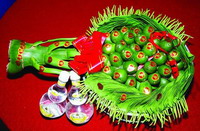 A long time ago, when the legendary Hung kings still ruled the land,there lived two brothers, Tan and Lang, in a small village. Although not twins, they resembled each other like two drops of water. They had the same lofty brows, the same straight noses, and the same intelligent, sparkling eyes. They were both handsome, they loved each other above all else and one was never seen without the other.
A long time ago, when the legendary Hung kings still ruled the land,there lived two brothers, Tan and Lang, in a small village. Although not twins, they resembled each other like two drops of water. They had the same lofty brows, the same straight noses, and the same intelligent, sparkling eyes. They were both handsome, they loved each other above all else and one was never seen without the other.
The two brother were still young when a fire burned down their home, causing the death of their parents and the loss of all their possessions. The two young men were left in want, and to avoid charity, went out into the world in search of work. By chance they knocked at the door of Mandarin Luu, a intimate friend of their late parents. He received them into his stately mansion with a most cordial welcome. He had no sons of his own, but had a daughter, as fair as a white lotus, and as fresh as a spring rose. Wishing to tighten their bonds of friendship and affection, Mandarin Luu offered to give his daughter in marriage to one of the young men. They were both attracted by the good looks and graceful manners of the pretty maiden; and each secretly loved her. Their hearts were equally generous, however, and each insisted that the other should marry the girl. For her part, the maiden was unable to choose between the two young men, they were so alike. Tan and Lang would never have come to an agreement had the mandarin not used a clever little trick to find out which was the elder. He ordered a special meal prepared for his daughter and the " brothers. Two bowls of rice were brought to the table, but only one pair of chopsticks. Without hesitation, Lang picked up the chopsticks and in a very respectful manner handed them to Tan. Tan accepted them naturally, and Mandarin Luu immediately chose the elder brother to be the husband of his daughter. Although Huong was now Tan's wife, she still found it difficult to distinguish between him and Lang. She could only recognise her husband because he, following the tradition of the elder son, was always the first to enter the house and begin the meal.
But on one ill-fated evening when it was already dark, Lang was the first to enter the hut, for Tan was still busy out in the fields. Before he could warn Huong, she kissed him, convinced it was her husband. Just at that moment, Tan returned. The brothers began to argue. Tan was sure that Lang had deceived him and wanted to take his wife from him. He refused to listen to any explanations. Lang was deeply disturbed by the unjust accusation and fled from the house. He ran and ran and soon he was wandering aimlessly through the thick woods with no sense of direction. Finally he collapsed exhausted on the banks of a river and died. A good spirit who understood his sufferings turned Lang into a white, chalky stone as strong as the bonds that had tied him to his brother.
When Tan learned that Lang had stolen away from the house, he was extremely sorry and ashamed of the misunderstanding. Full of regret and troubled by his conscience, he set out to look for his young brother. He traversed the same route, crossed the same hills, and passed through the same forests, until he too reached the stone standing at the river's edge. Exhausted, he sat down with his back against a white chalky rock, and wept until he died. The spirit transformed Tan into a tall, slender Areka palm with green leaves like fans.
Huong waited many anxious days for the return of the two brothers. When she could bear her anxiety no longer, she set off to search for them. Now she too ran through the wood and and arrived at the site of the white chalky rock and the areca tree. Entirely worn out, she lay down to rest at the foot of the tree. Tears of despair rolled down her cheeks, and she kept on crying sorrowfully and thinking of her husband until she died. Once more, the spirit used its powers and transformed the young woman into a betel plant, which entwined itself around both the stone and the palm.
Enlightened by a dream, the peasants of the vicinity built a temple, in commemoration of the fraternal and conjugal love of the unfortunate brothers and the maiden. On the facade of the temple they inscribed the following motto: "Brothers united, spouses faithful." Years later, during a period of exceptional drought which marked the end of the reign of the fourth King Hung V¬ng, the areca tree and the creeping betel plant were the only green things remaining amidst the desolation. At the news of this miracle, pilgrims from all parts of the kingdom journeyed to the temple. King Hung V¬ng himself went there, and learned the story from the village notables. He was impressed by the tale and attempted to learn the divine intentions by asking his counselors the meaning of it all, but no one knew the answer. Finally, the minister of justice, a great and wise old man, said to the king: "Sire, when one wishes to assure himself of the consanguinity of brothers and sisters, or when one wishes to know the paternity of a child, the persons concerned are bled, and their blood is collected in the same bowl. If the blood coagulates the response is positive. We could crush together some leaves of the betel plant, with the fruit of the tree, and a fragment of rock. "
This advice was followed. The rock was heated and reduced to powder and the mixture took on a beautiful red color; the proof was clear. The king meditated and said: "This is the true symbol of fraternal and conjugal love. Let the tree and the plant be grown everywhere in commemoration of this beautiful story. " Brothers and sisters began to chew the quid of betel to demonstrate fraternal love, and newly wedded couples chew it to demonstrate conjugal love. The habit spread very quickly, until in the end it became the custom to offer the quid of betel at all social meetings "to maintain mutual affection". At Tet, it's a common offering to the ancestors and a popular entertainment to visitors. In addition, it's an essential offering to the Mother Godness.
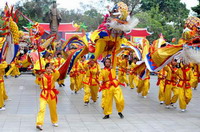 First Morning or Head Day is reserved for the nuclear family. Family members get together and celebrate with the husband's parents. A younger brother, if the parents are not alive, will visit his older sibling. Faraway sons and daughters journey to be with their parents on this day. Children anticipate a ritual called Mung Tuoi in which they are given small gifts, usually lucky money wrapped in red envelops. The words on the little red envelope may be "Respectful wishes for the New Year." With both arms folded in front of their chest in respect, they thank their grandparents for their birth and upbringing.
First Morning or Head Day is reserved for the nuclear family. Family members get together and celebrate with the husband's parents. A younger brother, if the parents are not alive, will visit his older sibling. Faraway sons and daughters journey to be with their parents on this day. Children anticipate a ritual called Mung Tuoi in which they are given small gifts, usually lucky money wrapped in red envelops. The words on the little red envelope may be "Respectful wishes for the New Year." With both arms folded in front of their chest in respect, they thank their grandparents for their birth and upbringing.
Reciprocally, the grandparents will impart words of advice or wisdom to their grandchildren, encouraging them to study hard, to live in harmony with others. The promises made by the children are similar to New Year's resolutions made during the western New Year. Adults will make silent promises to themselves to improve their lives, habits and relationships in the coming year.The family displays the offerings of food on the altar for the first meal for the ancestors since they have returned to the world of the living. The head of the family, dressed in fresh clothes, steps respectfully in front of the family altar and presents the offerings of food, liquor, cigarettes, betel fixings, flowers and paper gold and silver. He lights three sticks of incense, kneels, joins hands in front of his chest, bows his head and prays. The names of the deceased of the family up to the fifth generation are whispered as they are invited to participate in the feast prepared for them.
After the ceremony, the entire family sits down to enjoy the meal typically consisting of steamed chicken, bamboo shoot soup, banh chung and fresh fruits.
The whole family wait to welcome the visit by "the first-footer", who is believed to bring foretune and good luck to the family throughout the year.
Second Day
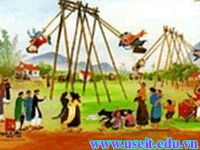 The second day of Tet is for visiting the wife's family and close friends. Some shops have opened and a few lottery stands are busy selling chances to people who feel lucky. Everyone is out on the street, parading around in their new clothes.
The second day of Tet is for visiting the wife's family and close friends. Some shops have opened and a few lottery stands are busy selling chances to people who feel lucky. Everyone is out on the street, parading around in their new clothes.
Third Day
On the third day of Tet, the circle of connections becomes larger and is extended to the broader community outside the family by visits to teachers, bosses or a helpful physician. The Vietnamese visit teachers and physicians although they have been out of school or cured of their illness for a long time. This may be the time to have one's fortune told to see what the coming year will bring. People are also especially interested in the significance of their first dream of the new year.
The evening of the third day marks the departure of the ancestors by burning votive objects such as paper gold and silver, for them to take with them on their journey back to Heaven.
The Traditional Greetings
The traditional greetings are "Chúc mừng năm mới" and "Cung chúc tân xuân" (Happy New Year). People also wish each other prosperity and luck. Common wishes for Tết include:
- Song lau tram tuoi (Live up to 100 years): used by children for elders. Traditionally, everyone is one year older on Tết, so children would wish their grandparents health and longetivity in exchange for mừng tuổi.
- An khang thinh vuong (Security, good health, and prosperity)
- Vạn sự như ý (May a myriad things go according to your will)
- Sức khoẻ dồi dao (Plenty of health)
- Cung hi phat tai from the Cantonese Kung hei fat choi (恭喜发财) (Congratulations and be prosperous)
- Tien vo nhu nuoc (May money flow in like water): used informally
These forbidden customs are not based on any scientific foundations, but they are the traditions passing from generation to generation and have become standard. With the opinion that the beginning impacts on the process and the end, Vietnamese people avoid doing bad things and try to do good things during Tết holiday.
Do's
- Should give people lucky presents to enhance the relationship between you and others: new clothes, Prunus persica branch (for expelling the evils), cocks (wish for good manner), new rice (wish for well-fed), rice wine in gourd (wish for rich and comfortable life), bánh chưng and bánh dày which symbolize sky and earth (for worship the ancestors), red things (red symbolize happiness, luckiness, advantages) like water melon, dog (the bark "bow-wow"
- gâu gâu like the pronunciation of the word giàu- richness in Vietnamese language), medicated oil (dầu in Vietnamese pronunciated like giàu- richness).
- Should give present lucky Dong Ho Painting such as: "Gà đàn" (wish for having many children), "Vinh hoa", but should's give present unlucky Dong Ho Painting like "Đánh ghen" related to legal proceedings.
- Should buy a lot of water on Tết holiday because people wish money flow in stream like water currents (proverb: "Tiền vô như nước").- Should sprinkle lime powder around the house to expel evil.- Should return all things you borrow, pay your debt before Tết
.- Should come back home before New Year's Eve if you don't want to be in difficult working.
Dont's
- Shouldn't say or do bad things during Tết.
- Shouldn't hurt or kill animals or plants but should set free them. That reason origins from Buddhism's causality.
- Shouldn't sweep the house and empty out the rubbish if people don't want to lose luckiness and benefit going away with the rubbish, especially on the first day of the new year.
- Shouldn't let the broom in confusion if people don't want to be stolen.
- Shouldn't give these presents to others: clock or watch (the receiver's time is going to pass), cat (mèo in Vietnamese language pronunciated like nghèo- poverty), drug (the receiver will get ill), cuttle fish (its ink is black, an unlucky colour), writing ink (for the same reason), scissors or knife (they bring incompatibleness).
- Shouldn't have duck meat because it brings unluckiness.
- Shouldn't have shrimp because they're afraid that they would move back like shrimp, in other words, they would not succeed.
- Shouldn't buy or wear white clothes because white is the colour of funeral in Vietnam.- Shouldn't let the rice-hulling mill empty because it sympolizes fail crops.-
- Shouldn't refuse all things other people give or wish you during Tết.

